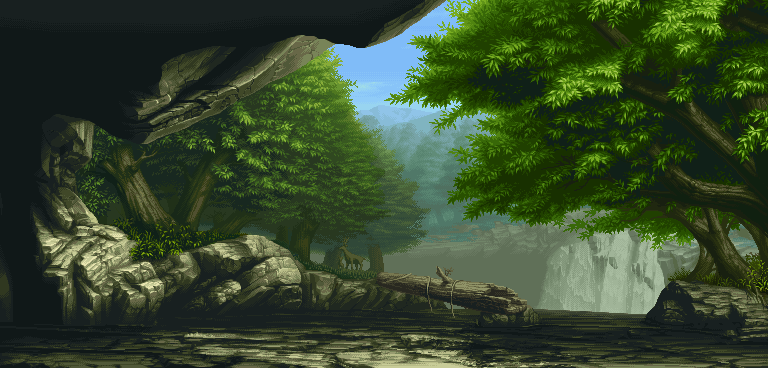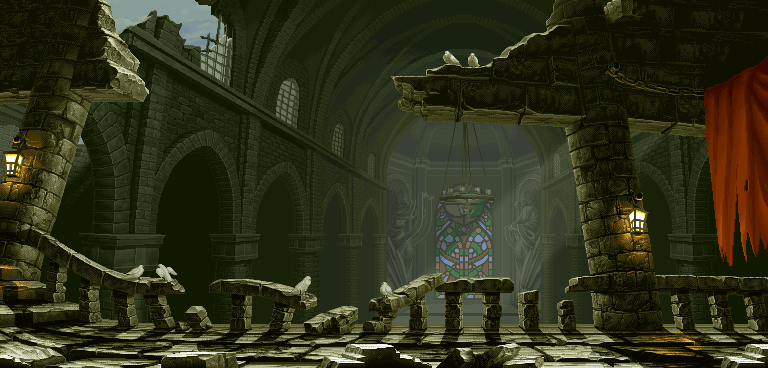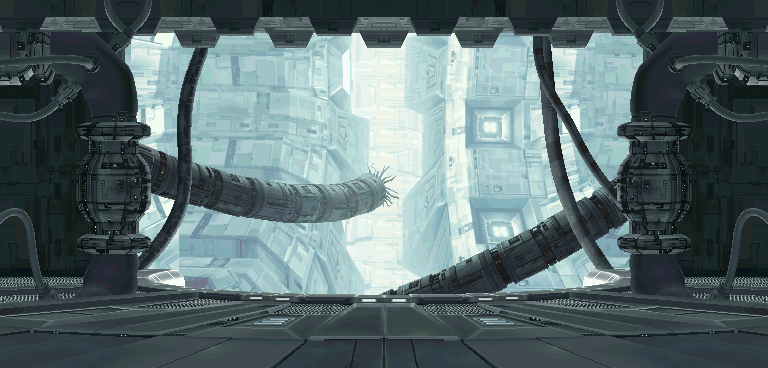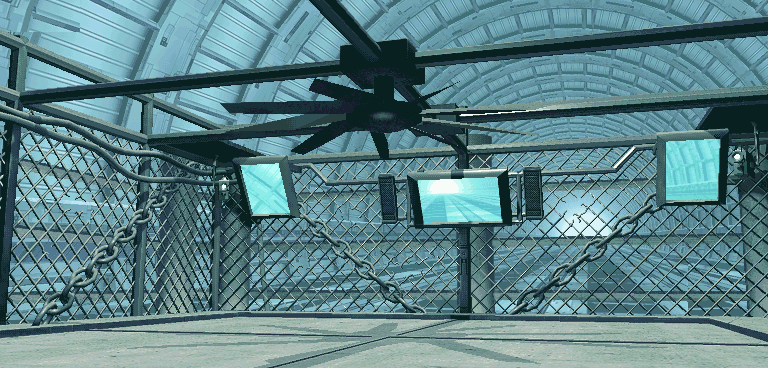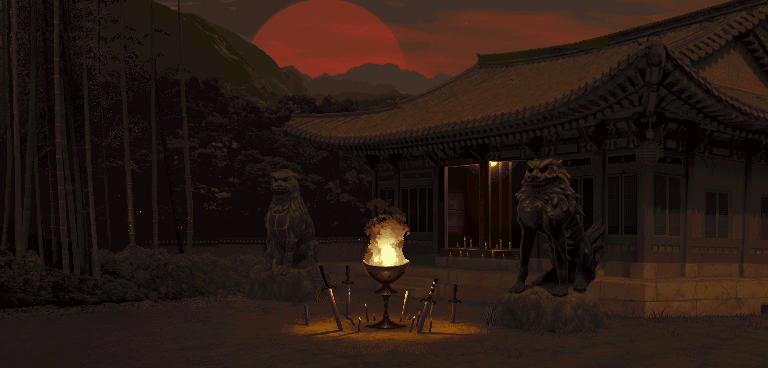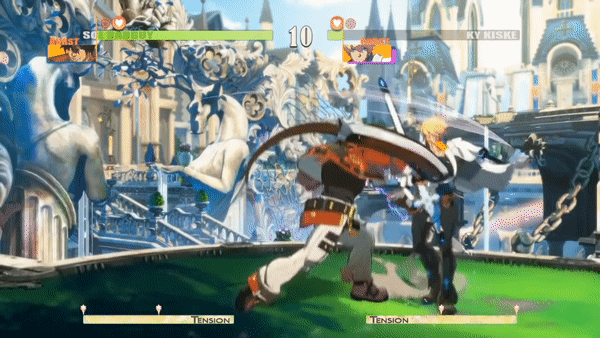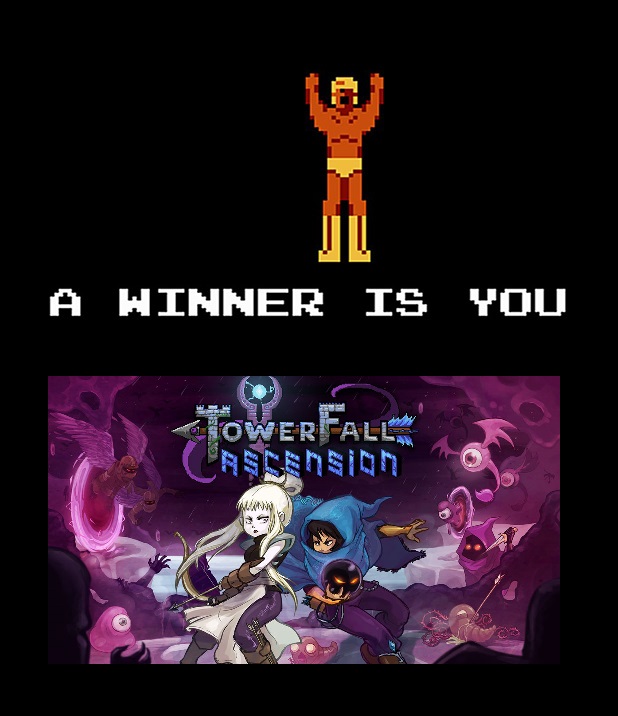- Instant Block & Instant Faultless Defense (IB window from 8f in Xrd/ACPR to 3f in Strive)
- I think IBs have too high of a requirement for the (still very good) reward they offer.
- Being 3f, they’re just a frame over slashbacks, which both negated pushback AND reduced any blockstun to 3f (which means, aside from conjoined attacks with projectiles/puppets, or some singular multi hit moves, you always had a gap for reversal as the fastest non-throw attacks in GG is 3f).
- The zero-pushback reward is def solid, but it’s clearly not gonna yield much vs projectiles in the corner, or against tick throws that depend on being + while being very close anyways, like airdash jump button > land command grab, or Sol’s long dash 2P>wild throw. You only have normal block and FD to change blockstun (+ the lingering throw protection) to mess with throw timings.
- The new IB does allow for a different usage. Pushback is cumulative, so with some strings you might need to IB 2 or 3 hits to make the ender punishable. It also means you don’t have to IB the last hit to make the best use of it. An example is if Ky corners you then does cS>Stun edge, IBing the cS means Ky would do stun edge point blank, which is fairly minus, and def punishable with throw or more even on normal block.
- Getting IB unintentionally by reacting and blocking late can be kind of more trouble than before. You might not want to be really close after blocking stuff
- The 3f window is even more confounding for IFD, since IFD is just enhanced FD, and still costs tension to use in addition to increasing blockstun the same amount. IFD is just a percentage better than FD, nowhere as substantial as IB’s no-pushback reward (basically if you can auto IB your normal block, it might make you unbeatable, but if you can auto IFD every FD it probably wouldn’t help you out that much)
- IFD does have this odd affect midscreen where it actually pushes the opponent away, while you remain still. It’s interesting but not sure it’ll matter much as long as you make them whiff.
- I do wonder if IFDing projectiles midscreen would just have you stay still while the opponent’s position is unaffected, which means with regards to projectiles, IFD and IB have the same effect. I think if they keep it like FD where it pushes you back, IFD would be more useful to get out of for example meaty projectiles midscreen by pushing yourself further than FD would.
- Because FD and IB have diametrically opposite effects, using them in combination is less useful. Classic example is Ky Xrd Rev 2 6H where the best option is to FD the first hit, then IB the second, so you get pushed out and then get blockstun reduced, slightly hindering Ky’s pressure. I don’t foresee reasons where for a particular string or multi hit attack, you’d want to be pushed back as much as possible for the first hit, then be NOT pushed back at all on the follow ups (or vice versa). To be clear, this is not taking into account dynamic changes to the string as the opponent reacts to your block options and adapt to it by changing the string.
- There’s more on this that I cover in the air block section
- I think IBs have too high of a requirement for the (still very good) reward they offer.
- Backdash+Dash Macro
- Backdash itself seems weaker. On average they take longer to complete, have less invul period, and the vulnerable recovery is longer (Distance travelled is possibly less too?). There’s also the fact that you seem to have a big hurtbox in that airbourne recovery, and you get juggled easily from their blockstring tagging you due to the new juggle system and they get a combo without needing for them to hitconfirm, let alone airbourne hit confirm. You can’t just “take an air hit then tech out”.
- Backdash is very good to escape throws now that there’s a throw whiff & no throw OS. It gets you an easy counter hit punish. But basically it is the optimal way to get out of throws, you can jump out, but jumping won’t make you able to punish throws by descending in time & you may even get anti aired for it.
- on the flip side, backdashing with the new dash macro is super effective. Going from 1 > 4+dash > 1 was really easy and there is much less risk of getting hit with lows during blockstun, or getting hit with mids with a 454 input during the neutral part of the input (in fact getting hit with mids is probably impossible, aside from hitting the backdash recovery? Can walk back then instantly backdash)
- It’s a game changer, and I wonder if the strength of the backdash macro is one consideration why they nerfed backdashes compared to Xrd. I personally wouldn’t mind them taking away backdashing with the macro & being manual only if it means backdashes can be buffed.
- 5D
- The hold vs tap idea is neat. 5Ds were really strong in the last beta due to them bouncing off the wall, so they yielded big meterless/no-set up damage while still being as fast as say Chipp’s 6K.
- It does still mean stuff like Chipp or Zato or May’s 6K overheads are kinda redundant. I guess they benefit from being gatling cancelable from 5P/2P unlike 5D. In fact I think for Zato, using the tap 5D in conjunction with Eddie might be more beneficial since the tap 5D is faster than his 6K as an overhead, but 5Ds might be easier to react to with the orange flash still there, or maybe 6K recovers faster so Zato can more easily follow it up vs 5D (assuming 6K can’t be special canceled)
- Throws
- being 2f means I get hit with attempting to throw after high jump ins that leave an exactly one frame gap before their button, or with 1f-gap-strings, but for higher jump ins or slower buttons or as a general disrespect it works really well defensively, or as quick reaction to like Leo’s berserker slash cross up. The instances where I got hit during start up were rare honestly so maybe I should just be more wary of spamming throws.
- bigger active frame window does mean that for super high jump ins, I’m able to press throw even while they’re in the air, even when the throw becomes active while they’re still in the air, then the meaty frames of the throw stay active till they land and I grab them. Means no more pressing throw too early and getting a slow 5H button that gets CH on ground instead of a throw.
- Air Throws
- still strong, was able to confidently use it defensively even for a character with no ground dash like Nagoriyuki to microdash before jumping to air throw better.
- Assuming there is a similar 2f start up, that means you probably can’t air throw people as low to the ground as before, but the throw is still fast enough that for most uses it’ll work fine
- Roman Cancels
- The usages for them I think have been understood much more clearly in this beta then before
- Red RC blast: the easy combo conversion/pressure reset tool, not always optimal since RC blast counts as a 0 damage hit that scales like a normal hit (if not having special scaling on it) + it takes a chunk off risc, but seeing how high damage everything is it might not matter much
- Blue RC: used for movement, “freeze the game and react”, and interesting pressure + mix up thanks to it having the longest slow down time, which lasts even after hitting the opponent. It does require you to be neutral and not in the middle of any move, so the best way to get it in a way where the opponent is locked down is on oki or after jump cancels and some dash cancels
- Purple RC: whiff safety, and combo/pressure extensions off projectiles (cause no hitstop). I thought there might be usages where you would purposely RC physical attacks late past their hitstop to get purple RC as a way to RC without the Red RC blast, but that’s negated with Fast Red RC for the most part
- Fast Red RC: New to this beta is canceling the blast+slowdown with normals, not just specials as in the 2020 beta. This probably is the way to get optimal combos that avoid the scaling from the Red RC blast, unless the blast’s huge launch time & slowdown affords you to do really slow attacks, like charged 5Ds (which seem to launch a bit and do decent damage on juggles). It’s also good for fast mix ups, like Ky blocked 214K into fast RC jK or fast RC drift down land 2K
- Purple and Blue RC can be made “fast” too, tho the usage might be situational. I seen stuff where Fast Blue RC (coupled with drift) after an airdash or a dash jump lets you carry that momentum ala Xrd’s airdash YRC. And Purple Fast RC has those classic Gunflame PRC forward drift Wild Throw or Hammer Fall PRC forward drift Pot Buster examples, so for stuff where u don’t want the opponent reacting to the RC freeze it makes sense. But for the purposes of making whiffs safe or for combos or pressure outside of immediate mix-ups after RC, I don’t know why you’d want to skip the slowdown circle, or even just the extra composure time, just to fast cancel to something, unless the slowdown (which does not count as a HIT in Blue/Purple RC) adds some scaling or tension pulse reduction or some hidden penalty
- Guard Yellow RC:
- I first was troubled by block RC because it just pushed characters a little bit and you get some frame advantage, but this reward seems like it’ll help some characters considerably (particularly grapplers that thrive on being slightly + while in their throw range), while for others it’s not very beneficial (like Zato Guard Yellow RCing Sol to push him right to Sol’s optimal counter poke range, so Zato would still be hesitant in pushing buttons even if he is + due to fear of Sol’s 2D/2P/5K/6P/DP or even revolver if that still has frame 1 strike invul)
- But it turns out, the game has this stagger state where the opponent is in a long stun animation and they can’t do anything but block, so presumably if you land a block RC, particularly a counter hit one that lasts longer, you can “true blockstring” into a button without worrying about reversals or counter pokes, so probably good to know what buttons to press to “jail them” into blocking. Even so, this still benefits some characters than others, and having this universal system be the replacement for tailor made dead angles means they probably can’t tune block RC’s reward to fit some characters more (or hinder it for ones that benefit off of it too much, or as part of that characters overall balance)
- Air Block + Ground & Air Gatling Restrictions
- dash jump block is strong, sorta like DBFZ, but air throw makes it less safe than there, where your best option in DBFZ is to staircase them to a ground string. You probably can still staircase here with jPPP~
- Chicken blocking on defense is strong cause you can block everything in the air, in addition to:
- 5P/2P starters don’t generally lead to lows aside from specials or specific low command normals like Nago’s 6K, so only chance to catch chicken blocking is to hit the jump start up, a 3f window on some characters
- 5K/2K gatlings can start from a low but either gatlings directly to another low with 2D, or command normals the same as above. Very hard to have a low > mid > low string just with normals, this all makes it hard to catch jump outs with a late low in a gapless blockstring without committing to 2D early
- with air block being able to block everything, and with how the new IB works, air IB and air FD/IFD still don’t have an apparent purpose.
- You don’t need FD to block DPs or ground normals in the air. Some Air DPs, particularly Ky’s, do push you away very far on normal air block making them safe. And apparently air IB would make u drop quicker in place so u can potentially punish them. Don’t know what air FD/IFD does vs DPs yet.
- air IB doesn’t reduce blockstun to allow air IB > air throw, plus the “negating pushback” aspect for air IB is not that useful when a lot of air interactions come from one side air dashing or dash jumping in on the other with a lot of momentum, so they’ll be real close whether you normal block or air IB. Air IB does seem to make you land sooner, but since landing while still in blockstun adds an additional 19f of landing recovery, you might not even be able to air IB > land > ground throw unless your blockstun ends while you’re still in the air & at that point you may as well air throw them.
- This is may sound like air defense against air pressure is weak, but the air gatling restrictions sorta even the field:
- Only infinite gatling button is jPPPP~ so while you can’t interrupt that string with air IB > air throw like before, they also can’t get a lot of hitstun/blockstun off of the last jP to get a big combo/blockstring on ground.
- jK only gatlings to jD & most jDs should have some landing recovery, some jDs even float & stop momentum so they aren’t gonna be super + upon landing.
- jSH might be interrupt-able on normal air block with an air throw if the jH is slow enough.
- Air IB was useful to deal with zoning tools like Axl’s buttons or fireballs, so air IBing them didn’t push you away. No blockstun reduction (+ the 19f landing recovery) meant it wasn’t as easy to capitalize on it to move forward with air IB > air dash or double jump forward as in previous GGs, or air IB > land dash, but I guess things are generally more committal on the ground end too in terms of attacks.
- ground and air dash cancels
- air dash cancel really strong for mix ups, but I think even the fastest ones are interrupt-able with 5Ps, certainly with 6Ps. They can also be good for approaching (like Ram doing max range sword jS a midscreen away then airdashing in with a jump button and being close enough to start pressure)
- ground dash cancel has some neat potential for pressure with dash cancel throw (was strong for Gio & May, less so for Sol) and combos, for juggles that allow button > dash > button or special, or for canceling to non-cancelable stuff like Sol’s Vortex (infinite or otherwise) or Fafnir, or Ram’s 214H big damage sword swing special, that way it kind of limits those specials to only be “canceled into” from dash cancelable buttons
Big thanks to @kedako_faital & @GREATFERNMAN for finding a lot of the technical data and translating it, which a lot of this post is based on.










